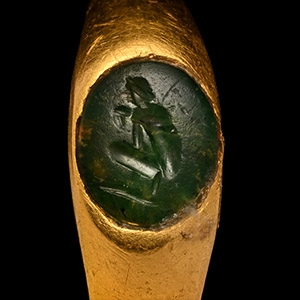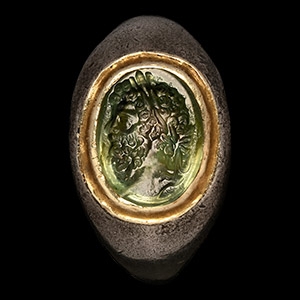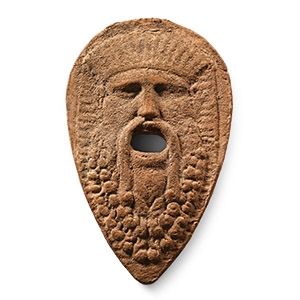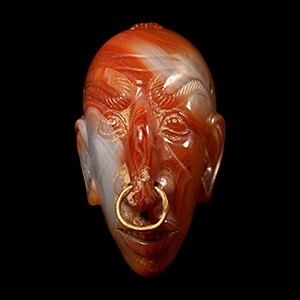Home > Auctions > 3 - 11 June 2025
Ancient Art, Antiquities, Books, Natural History & Coins
Acquired by the current owner's family in the 1980s.
with Christie’s, New York, Ancient Jewellery, 11 December 2003, no.463.
This lot has been cleared against the Art Loss Register database, and is accompanied by an illustrated lot declaration signed by the Head of the Antiquities Department, Dr Raffaele D'Amato.
Private family collection, acquired in the 1980s.
with Christie's, New York, Ancient Jewellery, 11 December 2003, no.506.
Property of a European collection.
Accompanied by a copy of an Art Loss Register certificate, no.S00029664
This lot is accompanied by an illustrated lot declaration signed by the Head of the Antiquities Department, Dr Raffaele D'Amato.
Acquired in the late 1980s-early 1990s.
Private collection, London.
This lot is accompanied by an illustrated lot declaration signed by the Head of the Antiquities Department, Dr Raffaele D'Amato.
English private collection, 1980s-1990s.
with Christie's, London, 7 October 2010, no.204.
European private collection, acquired in 2010.
Accompanied by copies of the relevant Christie's catalogue pages.
Accompanied by an academic report by Dr Raffaele D’Amato.
This lot has been checked against the Interpol Database of stolen works of art and is accompanied by a search certificate number no.12609-234621.
This lot has been cleared against the Art Loss Register database, and is accompanied by an illustrated lot declaration signed by the Head of the Antiquities Department, Dr Raffaele D'Amato.
Cf. coins with bust portraits of Septimius Severus from mints of Antiochia, Ancyra, Tavium, in Arslant, M., Museum of Anatolian Civilizations, Roman Coins, Istanbul, 1992, pls.95-97, for parallels; Baydur, N., Roman Sikkeleri, Istanbul, 1998, figs.222 and 225; Marsden, A., Roman Coins found in Britain, Witham, 2001, p.23, fig.39; cf. also Richter, G.M.A., The engraved gems of the Greeks, Etruscans and Romans, part two: Engraved Gems of the Romans: A supplement to the History of Roman Art, London, 1971, nos. 572 ss; Volleinweider, M-L., Camées et Intailles. Les portraits romains du Cabinet des médailles, Paris, 2018, Tome II nos. 204 ss; for a recent work on the iconography of the Imperial family of the Severans see Petruccioli, G., The portraiture of Caracalla and Geta: form, context and function, Oxford, 2011.
Comparison with contemporary coinage confirms that this bust with its prominent nose, chin, curly hair and forked tip beard, represents Septimius Severus (193-211 A.D.), and the image certainly conveys the strong character of the commander who led the Roman army to victory, not only in Europe but also in the Middle East. A similar portrait can be seen on the cameo in the Museum of Fine Arts, Boston (accession no.99.368). In the Boston cameo the emperor is likewise seen in profile, facing right, and his beard, with the forked tip, is identical. Another good comparison is with the cameo of the Imperial family preserved at the Cabinet des Medailles, Paris (Petruccioli, 2011, fig.230). Cameos and rings of this typology were often gifted and gifted to members of the Imperial entourage, and were a great instrument of Imperial propaganda.
Acquired in 1997 from a Canadian dealership.
From a North American gentleman's collection.
This lot has been cleared against the Art Loss Register database, and is accompanied by an illustrated lot declaration signed by the Head of the Antiquities Department, Dr Raffaele D'Amato.
Cf. statuette in bronze of the same typology in Getty Museum, inventory no. 78.AC.336.
The motif of an eagle and a stag or a deer is typically associated with the God Jupiter/Zeus Dolichenus and his wife Juno Dolichena, name derived from his sanctuary in Doliche, Anatolia. Jupiter Dolichenus was a soldier god, usually portrayed wearing full military attire and standing on a bull, while his consort would have been shown standing on a deer or stag.
Ex Cambridge, UK, collection, 1990-2010.
This lot is accompanied by an illustrated lot declaration signed by the Head of the Antiquities Department, Dr Raffaele D'Amato.
Cf. Durham, E., Metal Figurines in Roman Britain, vol. 2, Reading, 2010, item 293, for type.
with Münzen und Medaillen AG, Basel, Switzerland, 1974.
Swiss private collection.
Mr F. collection, Los Angeles, acquired in 2005.
This lot is accompanied by an illustrated lot declaration signed by the Head of the Antiquities Department, Dr Raffaele D'Amato.
Cf. Iran: pièces du Musée de Téhéran, du Musée du Louvre et de collections particulières, exhibition catalogue, Paris, Musée Cernuschi, 1948, pp.36, no.57.
with Münzen und Medaillen AG, Basel, Switzerland, 1974.
Swiss private collection.
Mr F. collection, Los Angeles, acquired in 2005.
This lot is accompanied by an illustrated lot declaration signed by the Head of the Antiquities Department, Dr Raffaele D'Amato.
Cf. lamp with similar maker's stamp in the BritIsh Museum under accession no.1905,0520.157.
From the private collection of Ambassador G.P., no.126, before 1965.
with Galerie Rhéa, Zurich, Switzerland.
This lot is accompanied by an illustrated lot declaration signed by the Head of the Antiquities Department, Dr Raffaele D'Amato.
Donald Bailey (curator emeritus at the British Museum) believes that the workshop of 'FAVSTI' oil lamps was Italian in origin, later relocating to Petra and Egypt. A large quantity of these oil lamps were also found in Cyprus including those of the Cesnola Collection at the Metropolitan Museum of Art.
Charles Winn (1795-1874), 8th Baronet of Nostell Priory, Yorkshire, UK; thence by descent.
with Christie's, London, UK, 1998, no.319.
with Galerie Rhéa, Zurich, Switzerland.
This lot is accompanied by an illustrated lot declaration signed by the Head of the Antiquities Department, Dr Raffaele D'Amato.
From the 'S' collection, acquired 1970-1990s.
The collection was seen and studied by W.G. Lambert, late Professor of Assyriology at the University of Birmingham, 1970-1993.
This lot has been cleared against the Art Loss Register database, and is accompanied by an illustrated lot declaration signed by the Head of the Antiquities Department, Dr Raffaele D'Amato.
Giorgio Sangiorgi (1886-1965), Rome, acquired and brought to Switzerland, late 1930s; thence by continuous descent to the current owner.
with Christie's Ancient Jewellery, New York, 6 December 2007, no.338.
This lot has been checked against the Interpol Database of stolen works of art and is accompanied by a search certificate number no.12582-232140.
This lot has been cleared against the Art Loss Register database, and is accompanied by an illustrated lot declaration signed by the Head of the Antiquities Department, Dr Raffaele D'Amato.
See the Walters Art Museum, no.42.870, for a similar style Roman intaglio with Ouroboros.
The image of Ouroboros (a snake eating its own tail) is usually associated with stars and Egyptian mythology as represented in Roman gnostic intaglios. Ouroboros is continuously re-birthing itself and depicted as a circle, representing eternity and the cyclical nature of things that start once they end. It is also the symbol of duality and dualising power.
85 - 96 of 3130 LOTS





.jpg)
.jpg)
.jpg)
.jpg)
.jpg)


.jpg)



